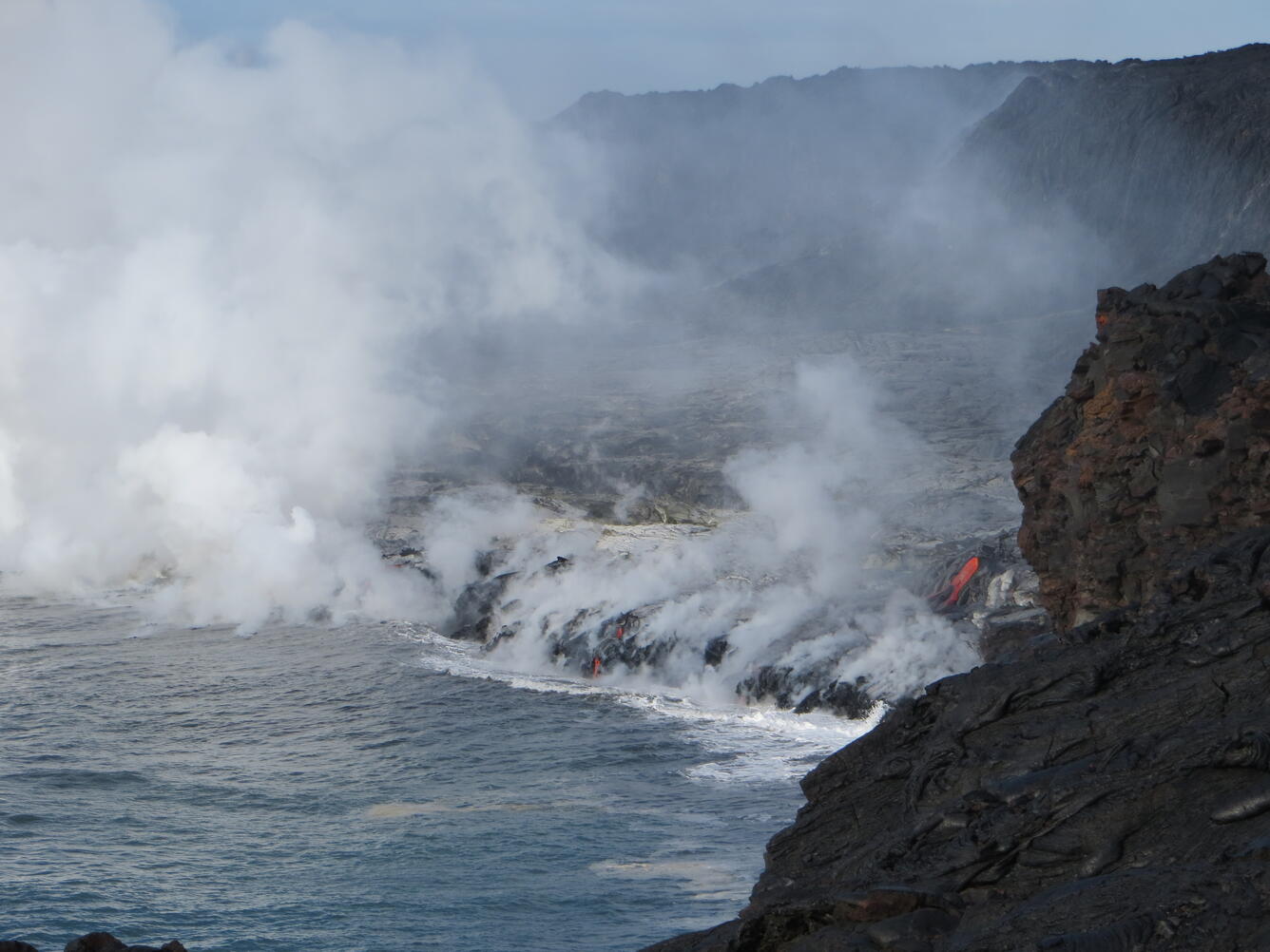Volcano Watch — January 2017 is Hawai‘i Island's 8th annual Volcano Awareness Month
The New Year is just around the corner, so it's time to remind everyone that January is Volcano Awareness Month on the Island of Hawai‘i.
Volcano Awareness Month was established by mayoral proclamation in 2010. Each January since, USGS Hawaiian Volcano Observatory (HVO) scientists have offered various talks—a total of 68 to date—at venues around the island to keep residents and visitors informed about Hawaiian volcanoes.
January was selected as the "official" Volcano Awareness Month mainly because Kīlauea's ongoing East Rift Zone (Pu‘u ‘Ō‘ō) eruption began on January 3, 1983. But with two of the world's most active volcanoes—one erupting nearly non-stop for over three decades (Kīlauea) and the other stirring for over a year (Mauna Loa)—the need for volcano awareness on Hawai‘i Island is not limited to only one month. It's a year-round concern.
In addition to the 34th anniversary of Kīlauea Volcano's current East Rift Zone eruption, January 2017 marks the 110th anniversary of a notable Mauna Loa lava flow. The two-week-long eruption began at the summit of Mauna Loa on January 10, 1907, but soon migrated down the volcano's Southwest Rift Zone. From there, lavaadvanced downslope and crossed the government road (predecessor of Highway 11) in two places. It was the first of four 20th century Mauna Loa Southwest Rift Zone eruptions that sent lava flows across the main circle-island road, blocking traffic and severing communication lines (the others were in 1919, 1926, and 1950).
These present and past Kīlauea and Mauna Loa eruptions are reminders of why it's important to understand how Hawaiian volcanoes work and the hazards associated with them. With that in mind, HVO, in cooperation with Hawai‘i Volcanoes National Park and the University of Hawai‘i at Hilo, will offer a series of volcano awareness talks in January 2017.
Details about these presentations, including dates, times, locations, and brief descriptions, are posted on HVO's website (http://hvo.wr.usgs.gov). You can also email askHVO@usgs.gov or call (808) 967-8844 for more information. For now, an overview of the January schedule follows.
Weekly "After Dark in the Park" programs in Hawai‘i Volcanoes National Park begin on Jan. 3 with a review of Kīlauea's ongoing East Rift Zone and summit eruptions over the past year. The next four Tuesday evening programs (Jan. 10, 17, 24, and 31) include a talk on "listening" to Kīlauea, the story of Halema‘uma‘u Crater's 200-year-long history, a look at the tools and techniques used by HVO geologists to track lava, and an update on the current status of Mauna Loa, respectively. Each presentation begins at 7:00 p.m. in the Kīlauea Visitor Center (Park entrance fees may apply).
Two Thursday evening programs will be held on the University of Hawai‘i at Hilo Main Campus in the University Classroom Building (UCB), Room 100. On Jan. 5, a review of Kīlauea's eruptions during the past year (a repeat of the Jan. 3 Park program) will be presented. The Jan. 19 talk addresses earthquakes in Hawaii, why they happen and what they tell us about volcanic eruptions. Both talks begin at 7:00 p.m.
A North Hawai‘i presentation on Wednesday, Jan. 18, focuses on volcanic air pollution (vog)—its origin and impacts, as well as new resources for living with vog in Hawaii. This talk will be held in the Gates Performing Arts Center on the Hawai‘i Preparatory Academy campus in Waimea, starting at 6:30 p.m.
In West Hawai‘i, an overview of Mauna Loa, Hualālai, and Kīlauea volcanoes will be presented on Wednesday, Jan. 25, in the Konawaena Elementary School cafeteria in Kealakekua. It begins at 6:30 p.m.
The West Hawai‘i talk will be repeated at Lyman Museum in Hilo on Jan. 30 and Feb. 2. The museum is also hosting a presentation on geologic features along the saddle between Mauna Loa and Mauna Kea on Jan. 12 and Jan. 16. Details are now posted on HVO's website (or visit http://lymanmuseum.org later this month).
Volcano Awareness Month talks are open to the public and no reservations are required.
Please join us in January to learn more about the volcanoes on which you live, and to meet some of the HVO scientists who monitor and study them. Until then, safe and happy holidays!
Volcano Activity Update
Kīlauea continues to erupt at its summit and East Rift Zone. This past week, the summit lava lake level varied between about 12.5 and 32 m (41–105 ft) below the vent rim. The 61g lava flow continued to enter the ocean near Kamokuna. The breakout from the 61g vent area on the flank of Pu‘u ‘Ō‘ō remained active, with a small surface flow slowly advancing to the east. The 61g lava flows do not pose an immediate threat to nearby communities.
Mauna Loa is not erupting. During the past week, small (less than magnitude-3) earthquakes occurred primarily at the summit and upper Southwest Rift Zone at depths less than 5 km (3 mi) and on the volcano's east flank at depths of 5–13 km (3–8 mi). Deformation related to inflation of a magma reservoir beneath the summit and upper Southwest Rift Zone continued.
No earthquakes were reported felt on the Island of Hawai‘i this past week.
Get Our News
These items are in the RSS feed format (Really Simple Syndication) based on categories such as topics, locations, and more. You can install and RSS reader browser extension, software, or use a third-party service to receive immediate news updates depending on the feed that you have added. If you click the feed links below, they may look strange because they are simply XML code. An RSS reader can easily read this code and push out a notification to you when something new is posted to our site.


